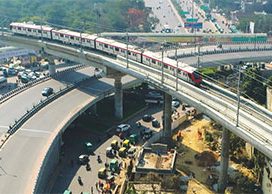What is the role of technology in providing solutions to public transit bodies. The way one could define, this is providing seamless multi-modal integrated travel. We will have to talk at three-levels: Technology to improve the asset management, resource management and operation management. In an interesting and informative panel discussion held during TrafficInfraTech Expo 2016 in last September, Nicolas Morael, Regional Sales Manager-Asia, Ixxi (RATP Group), Serbjeet Kohli, Director, Steer Davies Gleave, Dhawal Ashar, Senior Associate- Urban Transport & Road Safety, WRI India (who moderated the session), and Yashas Bhargav, Public Transport Specialist, Lumiplan ITS India Pvt Ltd agreed that technology backed public bus systems can bring in great changes.
Serbjeet Kohli: Steer Davies Gleave has helped Pune Municipal Corporation to improve the bus operations and passenger information systems. We believe transport can change the world; we plan, design and advise for both public and private transportation institutions with an objective of providing better transportation solutions to everyone and everywhere.

Technology is going to take a leap in choosing the public transport and all other available modes. This cannot happen just by saying we have a technology and let us get an app; it need to build an underline architecture, database has to be put in globally integrated system which can talk to each other and also an API.
– Serbjeet Kohli
We got involved with Pune in the beginning of 2016 with support from UK Trade and Investment (UKTI) which is also supporting Indore and Amravati. The Pune Corporation’s ‘Smart City’ vision says that it wants to improve the availability, reliability and passenger comfort of public bus services. The vision goes into some level of technical details of defining GPS, real-time monitoring, smart bus-stops, real-time tracking and vehicle health monitoring, which are all elements of good ITS for Public Transport System. But we had to take a step back to understand what were the real problems. Even though PMC had invested significantly in BRT Corridor but it has not been able to restrict the slide in the modal share of the buses with people moving to private modes of transport. The corporation wanted to go back and use the technology to arrest this downward spiral and SDG’s job was essentially to look at how can the technology help in: improving the bus operations performance and improving passenger information. We wanted to understand what the existing ITS architecture was and which components were in place. So, the approach we took was to define what an ideal ITS system should look like, it should have a component of sensing system and a network on how the sensing system should be talking to the control center and vice versa. These are not just the physical video panels that people are familiar with at modern bus/BRT stops; these include simple set ups where the central control system understands the different elements of bus operation– the bus network, bus routes, bus-stops, buses and where the fares are being collected. These control centers need to be talking to all the systems which provide information to passengers on the important elements such as the nearest bus stop, arrival of next bus, route and journey time to the destination and the travel fare. They also enable the central control center to talk to external APIs (Application Program Interface) which can be used by third parties to provide add-on services to users.
The red colour in the diagram indicates what the Pune Corporation does not have and the green & orange colours in the diagram indicate what the corporation has or in the process of acquiring.
 As it can be seen from the figure, there is a huge amount of investment that is being planned. Our job was aimed to see how this technological ITS architecture can help in solving the problems we had identified; we can eradicate or reduce. So, what we essentially found in this entire exercise was that there were key challenges which appropriately designed ITS solutions could help overcome and deliver a public transport system that operates efficiently and is easily accessible to all passengers.
As it can be seen from the figure, there is a huge amount of investment that is being planned. Our job was aimed to see how this technological ITS architecture can help in solving the problems we had identified; we can eradicate or reduce. So, what we essentially found in this entire exercise was that there were key challenges which appropriately designed ITS solutions could help overcome and deliver a public transport system that operates efficiently and is easily accessible to all passengers.
Another thing we noticed during our work was that it appears that in most transport investments, the focus is generally on specific infrastructure projects like metro, railways or airport. We need to consider end-to-end journey; people just do not jump to the metros and end their journey just by coming out of the metro station. There is an element of last mile connectivity in this, which we tend to forget; we just leave it to another authority to take care of it.
 TrafficInfraTech Magazine Linking People Places & Progress
TrafficInfraTech Magazine Linking People Places & Progress



